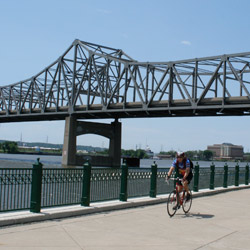
The Illinois River is a defining feature of our region. The economic, recreational and quality-of-life benefits it provides helps make central Illinois an inviting place to live and work. However, the calm waters we see on the surface belie a significant threat: pollution.
An unfortunate consequence of development in our region has been a negative impact on the water quality of the Illinois River. Local groups such as Heartland Water Resources Council and Peoria Lakes Basin Alliance have highlighted this concern, and the City of Peoria’s recent effort to reduce combined sewer overflows to the river has put water quality at the forefront of the region’s consciousness. So the question exists: How do we enable a healthy, growing region without compromising our most precious natural resource?
One solution lies in low impact development, an emerging development type that aims to preserve water quality. Known simply as LID, this method of land development was pioneered in Maryland during the 1990s and has spread throughout the nation. LID is a flexible, cost-effective approach to land development that mimics the functions of the natural landscape to improve the quality and reduce the quantity of stormwater runoff generated by new development.
LID employs a variety of site-specific “green” practices to absorb stormwater runoff and filter pollutants. Imagine a new residential subdivision is proposed for your community near a stream. A LID approach could include a narrower street, which would reduce the amount of impervious surface and subsequently reduce the volume of runoff generated. The grassy strip between the street and the sidewalk could include plantings designed to absorb runoff, reducing the need for curbs and gutters to collect runoff from the street. The runoff not absorbed by the plantings could be directed to a vegetated swale next to the sidewalk, where other vegetation will filter pollutants and allow the runoff to infiltrate the ground. The remaining runoff—much cleaner, and much less than that generated by conventional development—can be directed to a detention basis or nearby stream. The result: better water quality in our
local water bodies.
LID is not limited to residential areas, however. A shopping center parking lot can have vegetated filter strips and rain gardens to trap pollutants and absorb stormwater. A commercial building can store rain in rain barrels for watering landscaping on site. Because LID consists of a variety of site-specific practices, any development can become low impact development.
In addition to environmental benefits, choosing LID rather than conventional development can help the bottom line. The United States Environmental Protection Agency (EPA) studied different LID sites across the nation and determined that the cost of LID is often less than the cost of conventional development. The savings are the result of reduced costs for site grading and preparation, site paving, stormwater infrastructure—such as curbs and gutters—and landscaping. In addition, using LID practices to capture runoff on-site can reduce the size of stormwater detention areas, enabling more land to be developed. The EPA study can be accessed at epa.gov/owow/nps/lid/costs07/factsheet.html.
One significant hurdle to achieving LID is ordinance language that prohibits or restricts LID practices. In order to make LID easier to accomplish in our region, the Tri-County Regional Planning Commission has developed model subdivision, zoning and stormwater management ordinances that enable LID practices to be used. These ordinances are resources for communities seeking to revise their own ordinances and enable LID to occur. The ordinances can be viewed online at tricountyrpc.org/environment-page/model-environmental-protection-ordinances. Low impact development is another tool that will improve local development, and help improve local streams and the Illinois River along the way. iBi

